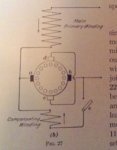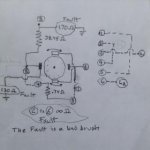hbiss
EC, New York NEC: 2017
- Location
- Little Falls, New York NEC: 2017
- Occupation
- EC
When did they start being able to use capacitors for motor starting? I don't think electrolytic capacitors were even available such as we know them much before the mid thirties.
So my thinking is that either this motor is much newer than the OP suggests, maybe the controller had a momentary "start" button that took the place of the centrifugal start switch or it is a repulsion/induction. I really don't think there is a capacitor in there but without a good look I can't be certain. It would be quite large. Open it up so we can see the back of the armature also.
-Hal
So my thinking is that either this motor is much newer than the OP suggests, maybe the controller had a momentary "start" button that took the place of the centrifugal start switch or it is a repulsion/induction. I really don't think there is a capacitor in there but without a good look I can't be certain. It would be quite large. Open it up so we can see the back of the armature also.
-Hal





